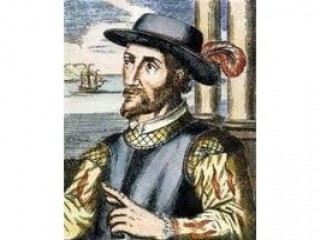
Juan Ponce De León biography
Date of birth : -
Date of death : -
Birthplace : Santervás de Campos, Castile
Nationality : Spanish
Category : Historian personalities
Last modified : 2011-08-23
Credited as : Explorer, conqueror, Governor of Puerto Rico
The Spanish conqueror and explorer Juan Ponce de León conquered the island of Puerto Rico and explored the coastline of Florida, which he claimed for the Spanish crown.
Juan Ponce de León was born in San Servas. Although of noble lineage, he was penniless and like so many destitute bluebloods sought fame and fortune as a soldier. He served in the 10-year conquest of the Moslem kingdom of Granada in southern Spain. Afterward, he heard exaggerated accounts of Columbus's discovery and migrated to the island of Hispaniola (modern Dominican Republic and Haiti).
After he had put down an Indian uprising in the eastern province of the island in 1504, the Indians told Ponce de León that he would find gold on a neighboring island to the east, called Boriquien (Puerto Rico). Four years later he crossed over and conquered the island. During the conquest he shared the honors with a famous greyhound dog named Bercerillo. It was said that the Indians were more afraid of ten Spaniards with the dog than one hundred without him. Ponce de León governed Puerto Rico until the King removed him from office in 1512.
Dispossessed of his office, Ponce de León obtained a royal grant to discover and settle the island of Bimini, which was believed to lie somewhere to the northwest. An incidental objective was to locate the wondrous spring whose waters would restore youth to the aged. The myth, repeated to Ponce de León by the Indians, was of European origin. According to the legend, the spring was in the Garden of Eden, which was located somewhere in Asia—the early Spaniards believing America to be Asia.
On March 3, 1513, Ponce de León sailed from Puerto Rico and a month later anchored near the mouth of the St. Johns River on the northeast coast of Florida. Impressed with its floral beauty and having landed at Eastertide, he named the land Florida, from the Spanish Pascua florida, "flowery Easter." While voyaging southward he encountered the strong current of the Gulf Stream as it poured through a channel. He had discovered the Bahama Channel, which later became the route of the treasure ships on their return voyage to Spain. He continued exploring the east coast and then sailed up the Gulf coast to Pensacola Bay. During his return voyage to Puerto Rico he sighted several small islands crowded with tortoises and named them the Tortugas, "tortoises."
In 1514 Ponce de León returned to Spain, where he received another grant, to colonize the "Island of Florida" at his own expense. In February 1521 the colonizing expedition landed on the Florida coast near Charlotte Harbor. The Native Americans attacked with such ferocity and persistence that the settlement was abandoned. Ponce de León, mortally wounded in battle, died a few days after having returned to Cuba. He was buried in Puerto Rico, the epitaph on his sepulcher reading, "Here rest the bones of a valiant LION [León], mightier in deeds than in name."
















